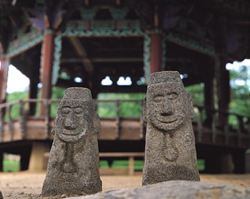|
 Unlike
Chong-ak, with its sense of emotional composure and control, Minsogak
is characterized by a rapid tempo and unrestrained, exuberant emotional
expression. Unlike
Chong-ak, with its sense of emotional composure and control, Minsogak
is characterized by a rapid tempo and unrestrained, exuberant emotional
expression.
Minsogak
vocal music includes the unique form known as p'ansori as well as minyo
and miscellaneous other types. In p'ansori, a single vocalist tells a
long story in which she or he assumes a number of different roles. At
present, there are five complete, traditional p'ansori compositions in
existence. The songs tend to be very long, with compositions such as Ch'unhyangjon
(Tale of Ch'unhyang) requiring more than eight hours to perform and Sugungga
(Song of the Underwater Palace) requiring more than four hours. Combining
a number of diverse formal elements, p'ansori alternates between a slow
and fast tempo, the quiet and dramatic, and melodic passages and passages
rendered in everyday speech. The music elicits numerous emotions, ranging
from sidesplitting laughter to profuse tears. Performed with the sole
accompaniment of a drummer, p'ansori, like most genres of folk music,
is performed with numerous ad-libs and improvisation.
Minyo are
broadly classified into three types according to region, namely, Kyonggi,
Namdo and Sodo minyo. Kyonggi minyo were traditionally popular in the
central area around Seoul, while Namdo minyo were popular in the southern
area around Cholla-do province and Sodo minyo were popular in the northwestern
area (present-day North Korea) situated around P'yong-an-do province.
Kyonggi minyo are generally characterized by a frantic tempo and cheerful
mood. As the music progresses, one feels happy and uplifted. Namdo minyo
have a relatively slow tempo and a crude, dark timbre. It's sharply alternating
melody gives one the sense of deep, inward pathos. Sodo minyo, with its
clear nasal tones and fine vibrato, reminds one of fine ripples spreading
outward on a lake. In contrast with Kyonggi minyo, it has a slow tempo
and pure, tranquil feeling reminiscent of a cool autumn sky.
In addition
to the above, there are a number of unique singing styles, generally classified
as chapka (miscellaneous songs), found in different regions throughout
Korea.
In terms
of melody and structure, these songs tend to be technically weak. Most
are based on an old text or story, and they are sometimes recited as if
from a book.
Among Minsogak
instrumental music, the most famous compositions are Sanjo, Shinawi and
the primarily percussion style known as Samul Nori. Sanjo basically consists
of three movements known as chinyangjo, chungmori and chajinmori. It is
widely performed as the basic repertoire of traditional solo instrumentalists.
Examples include the Kayagum (Kaya zither), Komun-go (half-tube zither),
P'iri (bamboo flute), Haegum (large transverse bamboo flute) and Ajaeng
(seven-stringed zither) sanjo.
Although
sanjo performers follow the basic three movements, they tend to freely
give the music their own unique interpretation. However, with the introduction
of Western-style notation, the music has recently become more rigidly
fixed. Sanjo music is popular as a style which allows the performer to
demonstrate his or her technical expertise while giving free rein to his
or her creative expression.
Shinawi,
on the other hand, is normally performed by a traditional instrument ensemble.
Within the form's loose structure, musicians freely display their individual
skill while harmonizing with the other members of the group. Like stars
in the night sky which shine individually yet are ultimately part of the
cosmic order, this musical form allows the maximum freedom for each musician's
unique expression within the context of group harmony. As a musical form
embodying Korean sentiment and timbre, this music, along with sanjo, is
easy to appreciate.
Samul Nori
is one of a traditional instrumental music that has won international
acclaim. The term Samul means "four" while Nori means to "play"
or "perform;" hence the name Samul Nori signifies a performance
using four instruments, namely, small and large gongs made of bronze and
leather and double-headed hourglass and barrel drums. These four instruments
were used in Nong-ak, a traditional, outdoor musical performance which
goes back into Korea's remote past. In Samul Nori, Nong-ak has been adapted
for indoor performances. Beginning in the late 1970s, Samul Nori rapidly
gained enthusiastic support from the general population, and there are
presently a number of active Samul Nori bands. The genre's subtle charm
comes from its free employment of the numerous rhythms found in Korea's
traditional music. The four percussion instruments used in this style
of music have their own unique function and tone colors. The instruments
are distinctly different in terms of musical range, timbre and resonance;
yet their sounds are brought together to form a harmonious whole.
|
![]()
![]() Korean Ritual Music 01
Korean Ritual Music 01